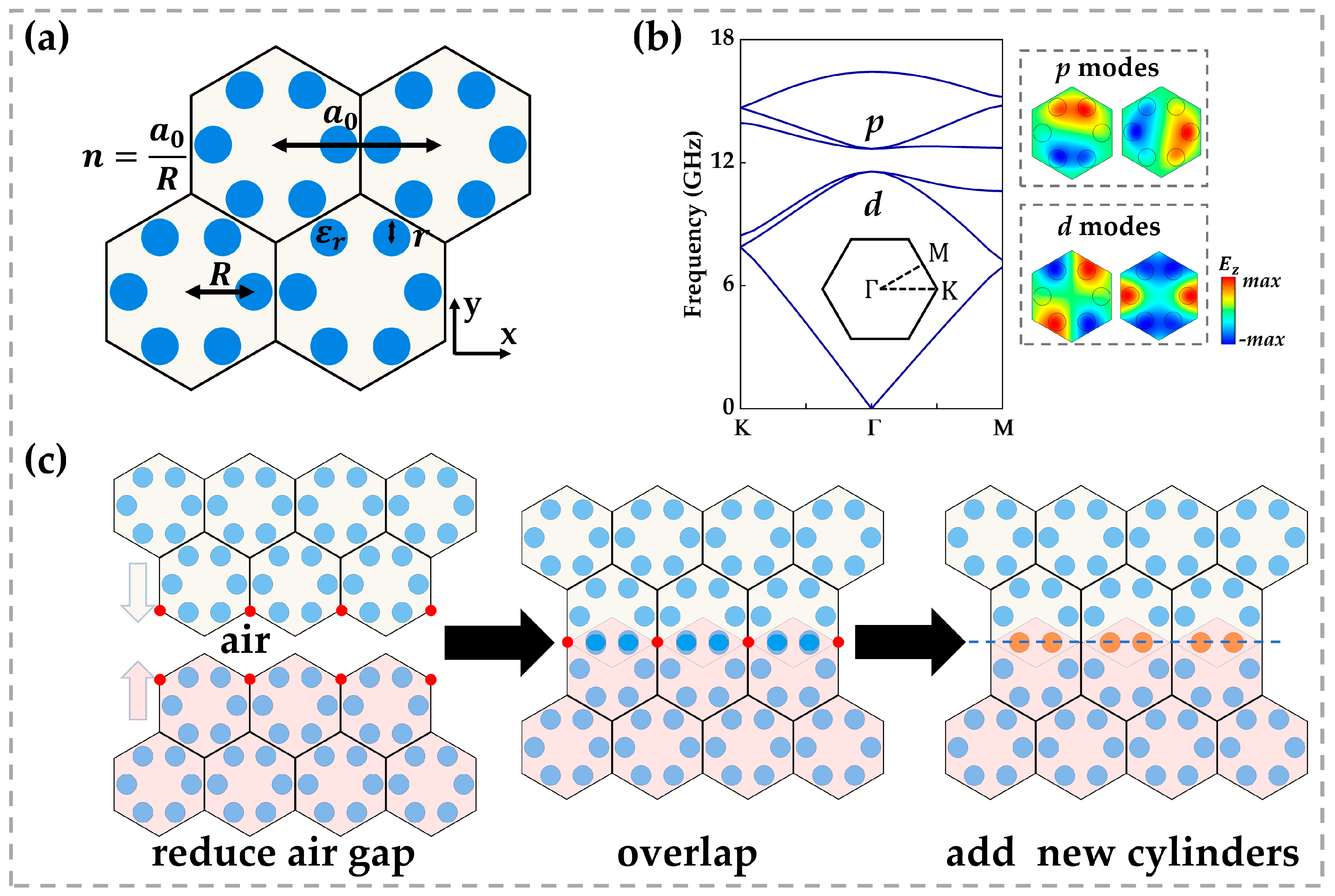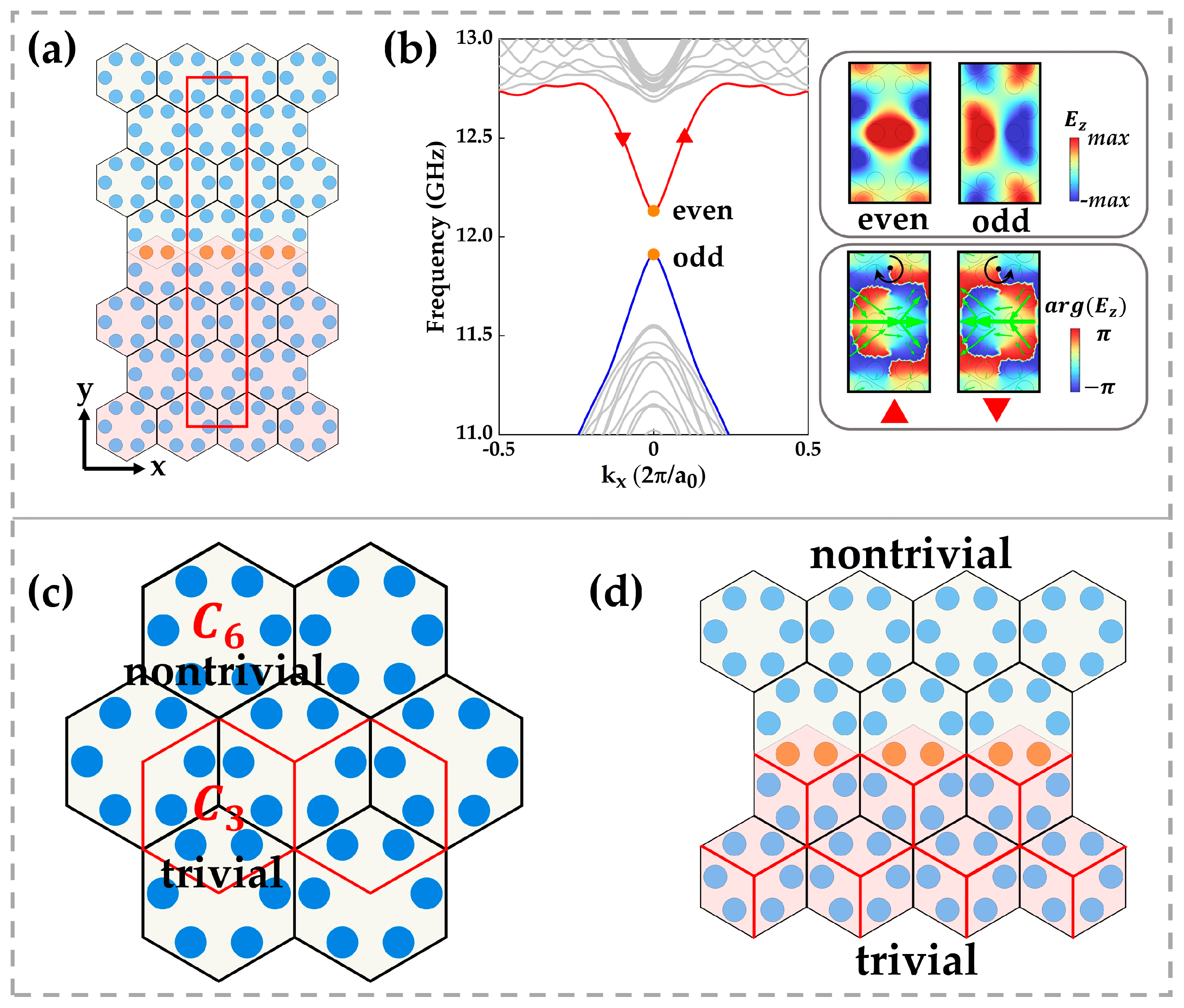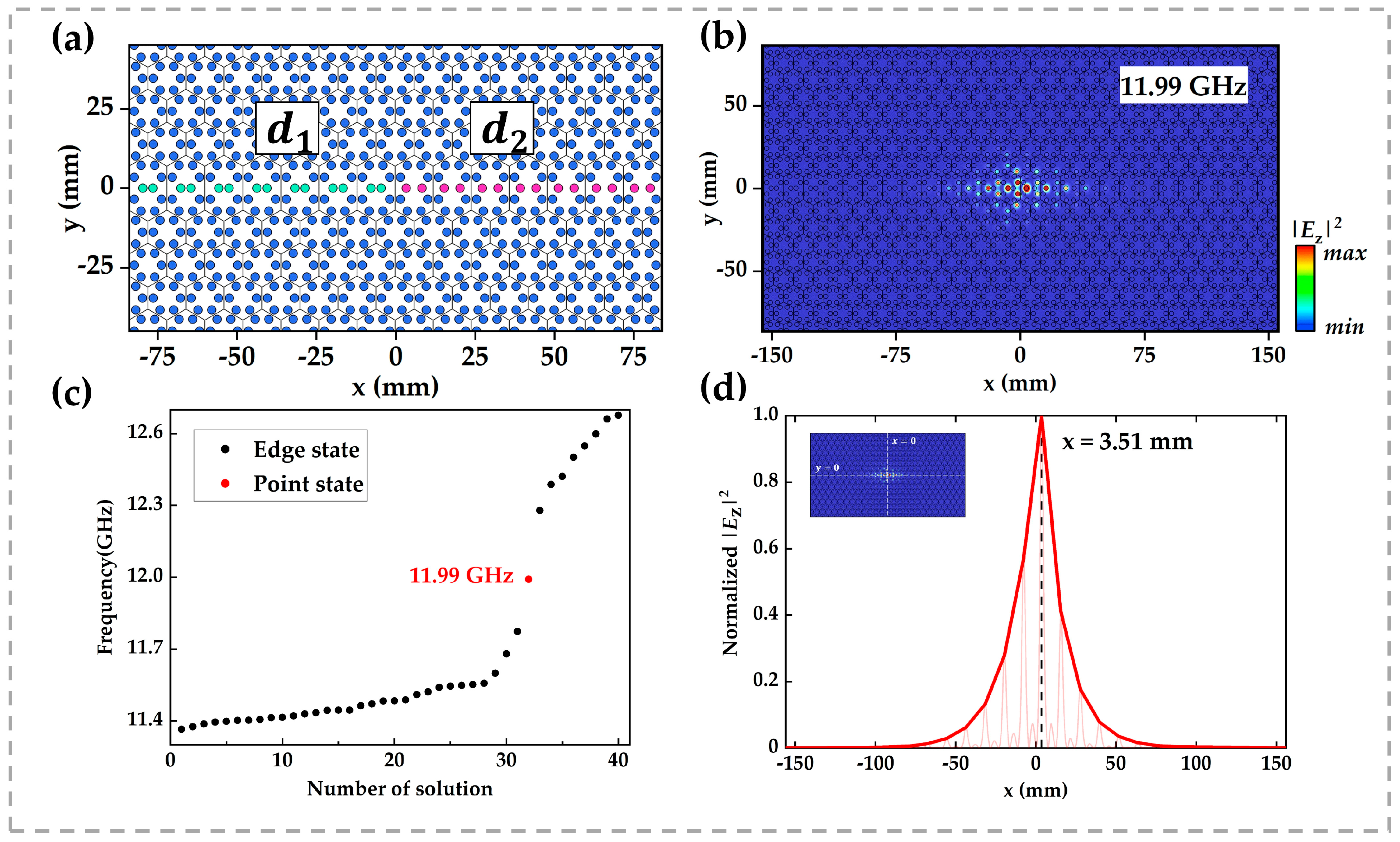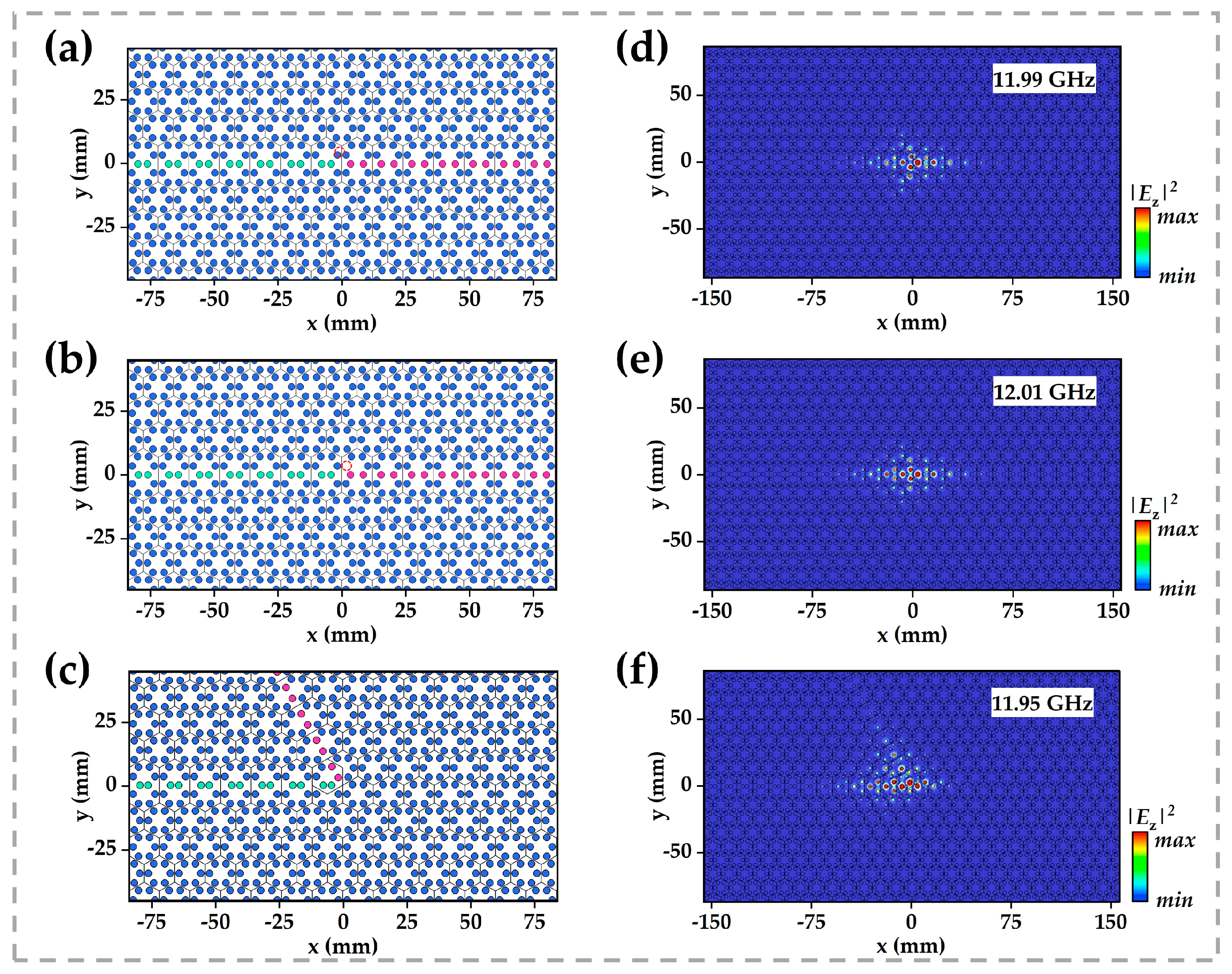Manipulation of Topological Edge States and Realization of Zero-Dimensional Higher-Order Topological Point States
Abstract
1. Introduction
2. Design of Mirror-Structured Topological Photonic Crystal Structures
3. Edge-State Band Inversion
4. Higher-Order Topological Modes
5. Conclusions
Author Contributions
Funding
Data Availability Statement
Conflicts of Interest
References
- Dorda, G.; Pepper, M.; Klitzing, K.V. New method for high-accuracy determination of the fine-structure constant based on quantized Hall resistance. Phys. Rev. Lett. 1980, 45, 494–497. [Google Scholar]
- Kane, C.L.; Hasan, M.Z. Colloquium: Topological insulators. Rev. Mod. Phys. 2010, 82, 3045–3067. [Google Scholar]
- Zhang, S.; Qi, X. Topological insulators and superconductors. Rev. Mod. Phys. 2011, 83, 1057–1110. [Google Scholar]
- Chong, Y.; Joannopoulos, J.D.; Soljačić, M.; Wang, Z. Reflection-free one-way edge modes in a gyromagnetic photonic crystal. Phys. Rev. Lett. 2008, 100, 13905. [Google Scholar]
- Wang, Z.; Chong, Y.; Joannopoulos, J.D.; Soljačić, M. Observation of unidirectional backscattering-immune topological electromagnetic states. Nature 2009, 461, 772–775. [Google Scholar] [CrossRef]
- Lu, L.; Joannopoulos, J.D.; Soljačić, M. Topological photonics. Nat. Photonics 2014, 8, 821–829. [Google Scholar] [CrossRef]
- Price, H.M.; Amo, A.; Goldman, N.; Hafezi, M.; Lu, L.; Rechtsman, M.C.; Schuster, D.; Simon, J.; Zilberberg, O.; Carusotto, I.; et al. Topological photonics. Rev. Mod. Phys. 2019, 91, 15006. [Google Scholar]
- Hatsugai, Y. Chern number and edge states in the integer quantum Hall effect. Phys. Rev. Lett. 1993, 71, 3697–3700. [Google Scholar] [CrossRef]
- Lin, Z.; Chan, C.; Ao, X. One-way edge mode in a magneto-optical honeycomb photonic crystal. Phys. Rev. B 2009, 80, 33105. [Google Scholar]
- Khanikaev, A.B.; Hossein Mousavi, S.; Tse, W.; Kargarian, M.; Macdonald, A.H.; Shvets, G. Photonic topological insulators. Nat. Mater. 2013, 12, 233–239. [Google Scholar] [CrossRef]
- Hu, X.; Wu, L. Scheme for achieving a topological photonic crystal by using dielectric material. Phys. Rev. Lett. 2015, 114, 223901. [Google Scholar]
- Xu, Y.; Xu, T.; Wang, H.; Jiang, J.; Hu, X.; Hang, Z.; Yang, Y. Visualization of a unidirectional electromagnetic waveguide using topological photonic crystals made of dielectric materials. Phys. Rev. Lett. 2018, 120, 217401. [Google Scholar]
- Yang, Y.; Jiang, H.; Hang, Z. Topological valley transport in two-dimensional honeycomb photonic crystals. Sci. Rep. 2018, 8, 1588. [Google Scholar] [CrossRef]
- Huang, S.; Chen, K.P.; Rechtsman, M.C.; Noh, J. Observation of photonic topological valley Hall edge states. Phys. Rev. Lett. 2018, 120, 63902. [Google Scholar]
- Shao, S.; Liang, L.; Hu, J.; Poo, Y.; Wang, H. Topological edge and corner states in honeycomb-kagome photonic crystals. Opt. Express 2023, 31, 17695–17708. [Google Scholar] [CrossRef]
- Yang, Y.; Jia, Z.; Wu, Y.; Xiao, R.; Hang, Z.; Jiang, H.; Xie, X. Gapped topological kink states and topological corner states in honeycomb lattice. Sci. Bull. 2020, 65, 531–537. [Google Scholar] [CrossRef] [PubMed]
- Wang, H.; Liang, L.; Jiang, B.; Hu, J.; Lu, X.; Jiang, J. Higher-order topological phases in tunable C3 symmetric photonic crystals. Photonics Res. 2021, 9, 1854. [Google Scholar] [CrossRef]
- Maczewsky, L.J.; Heinrich, M.; Kremer, M.; Ivanov, S.K.; Ehrhardt, M.; Martinez, F.; Kartashov, Y.V.; Konotop, V.V.; Torner, L.; Bauer, D.; et al. Nonlinearity-induced photonic topological insulator. Science 2020, 370, 701–704. [Google Scholar] [CrossRef] [PubMed]
- Guo, K.; Xue, Q.; Chen, F.; Zhou, K.; Liu, S.; Guo, Z. Tunable topological valley Hall edge state based on large optical Kerr effect. J. Appl. Phys. 2021, 130, 203105. [Google Scholar] [CrossRef]
- Zhao, Y.; Liang, F.; Han, J.; Wang, X.; Zhao, D.; Wang, B. Tunable topological edge and corner states in an all-dielectric photonic crystal. Opt. Express 2022, 30, 40515–40530. [Google Scholar] [CrossRef]
- Sui, F.; Chen, J.; Huang, H. Tunable topological edge states and rainbow trapping in two dimensional magnetoelastic phononic crystal plates based on an external magnetostatic field. Int. J. Mech. Sci. 2022, 225, 107360. [Google Scholar] [CrossRef]
- Xu, Y.; Ding, F.; Liu, F.; Tang, S. Continuously tunable topological defects and topological edge states in dielectric photonic crystals. Phys. Rev. B 2023, 107, L041403. [Google Scholar]
- Deng, W.; Shi, F.; Zhao, F.; Chen, M.; Dong, J.; Chen, X. Direct observation of corner states in second-order topological photonic crystal slabs. Phys. Rev. Lett. 2019, 122, 233902. [Google Scholar]
- Yang, X.; Liu, X.; Yu, S.; Gan, L.; Zhou, J.; Zeng, Y. Permittivity of undoped silicon in the millimeter wave range. Electronics 2019, 8, 886. [Google Scholar] [CrossRef]
- He, L.; Shen, Q.; Xu, J.; You, Y.; Yu, T.; Shen, L.; Deng, X. One-way edge modes in a photonic crystal of semiconductor at terahertz frequencies. Sci. Rep. 2018, 8, 8165. [Google Scholar] [CrossRef] [PubMed]
- Zhou, R.; Lin, H.; Wu, Y.; Li, Z.; Yu, Z.; Liu, Y.; Xu, D. Higher-order valley vortices enabled by synchronized rotation in a photonic crystal. Photonics Res. 2022, 10, 1244. [Google Scholar] [CrossRef]
- Deng, W.; Chen, X.; Zhao, F.; Dong, J. Transverse angular momentum in topological photonic crystals. J. Opt. 2018, 20, 14006. [Google Scholar] [CrossRef]
- Li, T.; Hughes, T.L.; Benalcazar, W.A. Quantization of fractional corner charge in Cn-symmetric higher-order topological crystalline insulators. Phys. Rev. B 2019, 99, 245151. [Google Scholar]
- Ghorashi, A.; Christensen, T.; Rechtsman, M.C.; Benalcazar, W.A.; Vaidya, S. Topological phases of photonic crystals under crystalline symmetries. Phys. Rev. B 2023, 108, 85116. [Google Scholar]
- Asbóth, J.K.; Oroszlány, L.; Pályi, A. A Short Course on Topological Insulators; Springer: Berlin, Germany, 2016. [Google Scholar]
- Zhang, X.; Wang, H.; Lin, Z.; Tian, Y.; Xie, B.; Lu, M.; Chen, Y.; Jiang, J. Second-order topology and multidimensional topological transitions in sonic crystals. Nat. Phys. 2019, 15, 582–588. [Google Scholar] [CrossRef]
- Lin, Z.; Wang, H.; Zhang, X.; Lu, M.; Chen, Y.; Jiang, J.; Xiong, Z. Corner states and topological transitions in two-dimensional higher-order topological sonic crystals with inversion symmetry. Phys. Rev. B 2020, 102, 125144. [Google Scholar]





Disclaimer/Publisher’s Note: The statements, opinions and data contained in all publications are solely those of the individual author(s) and contributor(s) and not of MDPI and/or the editor(s). MDPI and/or the editor(s) disclaim responsibility for any injury to people or property resulting from any ideas, methods, instructions or products referred to in the content. |
© 2025 by the authors. Licensee MDPI, Basel, Switzerland. This article is an open access article distributed under the terms and conditions of the Creative Commons Attribution (CC BY) license (https://creativecommons.org/licenses/by/4.0/).
Share and Cite
Ren, J.; Ding, W.; Wang, S.; Tang, S. Manipulation of Topological Edge States and Realization of Zero-Dimensional Higher-Order Topological Point States. Micromachines 2025, 16, 686. https://doi.org/10.3390/mi16060686
Ren J, Ding W, Wang S, Tang S. Manipulation of Topological Edge States and Realization of Zero-Dimensional Higher-Order Topological Point States. Micromachines. 2025; 16(6):686. https://doi.org/10.3390/mi16060686
Chicago/Turabian StyleRen, Jiahui, Wenjing Ding, Sihan Wang, and Shiwei Tang. 2025. "Manipulation of Topological Edge States and Realization of Zero-Dimensional Higher-Order Topological Point States" Micromachines 16, no. 6: 686. https://doi.org/10.3390/mi16060686
APA StyleRen, J., Ding, W., Wang, S., & Tang, S. (2025). Manipulation of Topological Edge States and Realization of Zero-Dimensional Higher-Order Topological Point States. Micromachines, 16(6), 686. https://doi.org/10.3390/mi16060686






